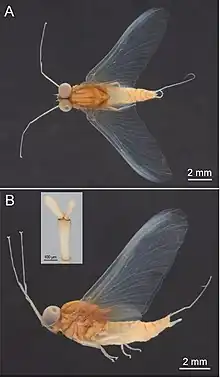Baetiscidae
Baetiscidae is a family of mayflies. It contains a single extant genus, Baetisca, native to North America with around 12 species.[1][2][3][4] The family is noted for their spined armoured larvae, which live in flowing water pools and on the edges of streams where they are detritivores, consuming fine particles of organic matter. Two other extinct genera are known, extending back to the Early Cretaceous. They are closely related to Prosopistomatidae which have unusual, beetle-like nymphs as well as the extinct genus Cretomitarcys, with the three groups constituting the clade Carapacea.[5]
| Baetiscidae Temporal range: | |
|---|---|
.jpg.webp) | |
| Baetisca berneri larvae | |
 | |
| Baetisca rogersi adult male | |
| Scientific classification | |
| Domain: | Eukaryota |
| Kingdom: | Animalia |
| Phylum: | Arthropoda |
| Class: | Insecta |
| Order: | Ephemeroptera |
| Suborder: | Carapacea |
| Family: | Baetiscidae Edmunds and Traver 1954 |
| Genera | |
|
See text | |
Genera
These two genera belong to the family Baetiscidae:[6][7]
- Baetisca Walsh, 1862 i c g b
- †Balticobaetisca Staniczek & Bechly, 2002 g Baltic amber, Eocene
- †Protobaetisca Staniczek 2007 Crato Formation, Brazil, Early Cretaceous (Aptian)
Data sources: i = ITIS,[1] c = Catalogue of Life,[2] g = GBIF,[3] b = Bugguide.net[4]
References
- "Baetiscidae Report". Integrated Taxonomic Information System. Retrieved 2018-05-05.
- "Browse Baetiscidae". Catalogue of Life. Archived from the original on 2018-05-06. Retrieved 2018-05-05.
- "Baetiscidae". GBIF. Retrieved 2018-05-05.
- "Baetiscidae Family Information". BugGuide.net. Retrieved 2018-05-05.
- Staniczek, Arnold H.; Storari, Arianny P.; Godunko, Roman J. (2022-08-17). "Revised systematics, phylogeny, and paleontology of the mayfly family Baetiscidae (Insecta: Ephemeroptera)". Arthropod Systematics & Phylogeny. 80: 389–409. doi:10.3897/asp.80.e82845. ISSN 1864-8312.
- "Mayfly Central". Retrieved 2018-05-05.
- "Fossilworks, Balticobaetisca". fossilworks.org. Retrieved 17 December 2021.
Further reading
- Arnett, Ross H. Jr. (2000). American Insects: A Handbook of the Insects of America North of Mexico (2nd ed.). CRC Press. ISBN 0-8493-0212-9.
- Barber-James, Helen M.; Gattolliat, Jean-Luc; Sartori, Michel; Hubbard, Michael D. (2008). "Global diversity of mayflies (Ephemeroptera, Insecta) in freshwater". Freshwater Animal Diversity Assessment. Springer. 595 (1): 339–350. doi:10.1007/978-1-4020-8259-7_37.
- Barber-James, H.; Sartori, M.; Gattolliat, J-L.; Webb, J. (2013). "World checklist of freshwater Ephemeroptera species". Retrieved 2018-05-05.
- Borror, Donald J.; Peterson, Roger Tory; White, Richard E. (1998). A Field Guide to Insects. Houghton Mifflin. ISBN 978-0395911709.
- Campbell, Ian C., ed. (1990). Mayflies and stoneflies: Life histories and biology. Springer. doi:10.1007/978-94-009-2397-3. ISBN 978-94-010-7579-4. S2CID 39201439.
- Edmunds Jr., George F. (1972). "Biogeography and evolution of Ephemeroptera". Annual Review of Entomology. Annual Reviews. 17 (1): 21–42. doi:10.1146/annurev.en.17.010172.000321.
- Gillott, Cedric (1980). Entomology. Plenum Press. ISBN 0-306-40366-8.
- Kellogg, Vernon L. (1905). American insects. H. Holt.
- Kluge, Nikita (2013). The phylogenetic system of Ephemeroptera. Springer Science & Business Media. doi:10.1007/978-94-007-0872-3. ISBN 978-94-015-3942-5. S2CID 39671739.
- Majka, C. (2009). "Thomas L. Casey and Rhode Island". ZooKeys (22): 267–283. doi:10.3897/zookeys.22.93.
- Misof, B.; Liu, S.; Meusemann, K.; Peters, R.S.; et al. (2014). "Phylogenomics resolves the timing and pattern of insect evolution". Science. 346 (6210): 763. doi:10.1126/science.1257570. PMID 25378627. S2CID 36008925.
This article is issued from Wikipedia. The text is licensed under Creative Commons - Attribution - Sharealike. Additional terms may apply for the media files.